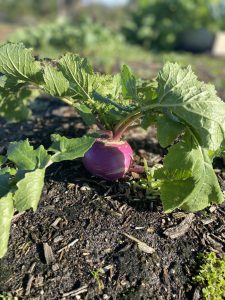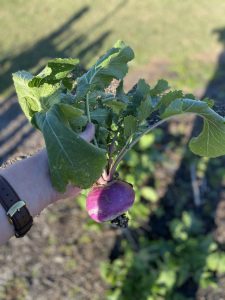The fall gardening season is exciting, especially because it is the time that many people begin planting after their summer break from gardening. Eventually the fall season slows to an end when mother nature provides a freeze to clear out some of the seasonal crops. But some vegetables avoid the frost burn all together and happily prance through the in-between seasons in our gardens.
One of these veggies is the humble turnip.
Ah, the turnip, the vegetable that may have out survived everything else in your garden but not the disappointment of when you realize you don’t know how to cook it. But before we talk about cooking it, let’s go into a bit of backstory about this rooty vegetable.
The turnip is a brassica, meaning it is related to vegetables such as (but not limited to) kale, collards, broccoli, and Brussels sprouts. As with many of the brassicas, turnips have been cultivated for thousands of years. They have been traced all over the world from eastern Asia to northern Europe. The popularity of turnips was brought to the south as settlers preferred the plant for its quick growing greens and roots, not to mention its tolerance to many environmental conditions.

Another important fact is that turnips are not rutabagas. They can look quite similar and are functionally like one another; however, they are not the same. Yet, in some areas of the world, rutabagas are referred to as turnips.
There are many different varieties of turnips on the market, some grown for their greens, some grown for their roots, and some for both. One of the most common turnips found in the U.S. is called Purple Top White Globe and can be used for both greens and roots. Turnips can have a similar bitterness to radishes and can be used similarly as well.

In terms of nutrients, turnips offer an array of vitamins. After speaking with our FCS agent, Hillary Ayers, she gave me the impressive nutritional information on turnips. The roots offer vitamin C, potassium, and fiber, while the greens offer folate, magnesium, calcium, fiber, vitamin A, vitamin C, and vitamin K. In addition, turnips only contain 17 calories per half cup serving.
Now that you know the background of turnips, below is a link to some recipes that work well with turnip roots.
https://www.foodhero.org/recipes/category/1891
As for turnip greens, you can cook them as you would other types of southern greens such as collards. However, keep in mind that the turnip greens may wilt faster than collards will.
I hope this blog gave you a little more appreciation for the age-old crop grown across the world. The turnip is not only fun and easy to grow, but it also makes a great addition to the dinner table as well.
Note: All images and contents are the property of UF/IFAS.



